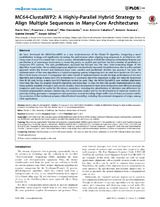Mostrar el registro sencillo del ítem
MC64-ClustalWP2: A Highly-Parallel Hybrid Strategy to Align Multiple Sequences in Many-Core Architectures
| dc.contributor.author | Díaz, David | |
| dc.contributor.author | Esteban, F.J. | |
| dc.contributor.author | Hernández, Pilar | |
| dc.contributor.author | Caballero, J.A. | |
| dc.contributor.author | Guevara, A | |
| dc.contributor.author | Dorado, G. | |
| dc.contributor.author | Gálvez, Sergio | |
| dc.date.accessioned | 2017-12-11T10:34:59Z | |
| dc.date.available | 2017-12-11T10:34:59Z | |
| dc.date.issued | 2014 | |
| dc.identifier.uri | http://hdl.handle.net/10396/15682 | |
| dc.description.abstract | We have developed the MC64-ClustalWP2 as a new implementation of the Clustal W algorithm, integrating a novel parallelization strategy and significantly increasing the performance when aligning long sequences in architectures with many cores. It must be stressed that in such a process, the detailed analysis of both the software and hardware features and peculiarities is of paramount importance to reveal key points to exploit and optimize the full potential of parallelism in many-core CPU systems. The new parallelization approach has focused into the most time-consuming stages of this algorithm. In particular, the so-called progressive alignment has drastically improved the performance, due to a fine-grained approach where the forward and backward loops were unrolled and parallelized. Another key approach has been the implementation of the new algorithm in a hybrid-computing system, integrating both an Intel Xeon multi-core CPU and a Tilera Tile64 many-core card. A comparison with other Clustal W implementations reveals the high-performance of the new algorithm and strategy in many-core CPU architectures, in a scenario where the sequences to align are relatively long (more than 10 kb) and, hence, a many-core GPU hardware cannot be used. Thus, the MC64-ClustalWP2 runs multiple alignments more than 18x than the original Clustal W algorithm, and more than 7x than the best x86 parallel implementation to date, being publicly available through a web service. Besides, these developments have been deployed in cost-effective personal computers and should be useful for life-science researchers, including the identification of identities and differences for mutation/polymorphism analyses, biodiversity and evolutionary studies and for the development of molecular markers for paternity testing, germplasm management and protection, to assist breeding, illegal traffic control, fraud prevention and for the protection of the intellectual property (identification/traceability), including the protected designation of origin, among other applications. | es_ES |
| dc.format.mimetype | application/pdf | es_ES |
| dc.language.iso | eng | es_ES |
| dc.publisher | PLOS | es_ES |
| dc.rights | https://creativecommons.org/licenses/by-nc-nd/4.0/ | es_ES |
| dc.source | PLoS ONE 9(4): e94044 (2014) | es_ES |
| dc.subject | Sequence alignment | es_ES |
| dc.subject | Multiple alignment calculation | es_ES |
| dc.subject | Heuristic alignment procedure | es_ES |
| dc.subject | CLUSTAL analysis | es_ES |
| dc.subject | Microprocessors | es_ES |
| dc.subject | Algorithms | es_ES |
| dc.subject | Phylogenetic analysis | es_ES |
| dc.subject | Jobs | es_ES |
| dc.title | MC64-ClustalWP2: A Highly-Parallel Hybrid Strategy to Align Multiple Sequences in Many-Core Architectures | es_ES |
| dc.type | info:eu-repo/semantics/article | es_ES |
| dc.relation.publisherversion | https://doi.org/10.1371/journal.pone.0094044 | es_ES |
| dc.relation.projectID | Gobierno de España. AGL2010-17316 | es_ES |
| dc.relation.projectID | Gobierno de España. BIO2011-15237-E | es_ES |
| dc.relation.projectID | Gobierno de España. RF2012-00002-C02-02 | es_ES |
| dc.relation.projectID | Junta de Andalucía. PAIDI AGR-248 | es_ES |
| dc.relation.projectID | Junta de Andalucía. PAIDI 041/C/2007 | es_ES |
| dc.relation.projectID | Junta de Andalucía. PAIDI 75/C/2009 | es_ES |
| dc.relation.projectID | Junta de Andalucía. PAIDI 56/C/2010 | es_ES |
| dc.relation.projectID | Junta de Andalucía. PAIDI AGR-7322 | es_ES |
| dc.relation.projectID | Junta de Andalucía. PAIDI AGR-482 | es_ES |
| dc.rights.accessRights | info:eu-repo/semantics/openAccess | es_ES |

